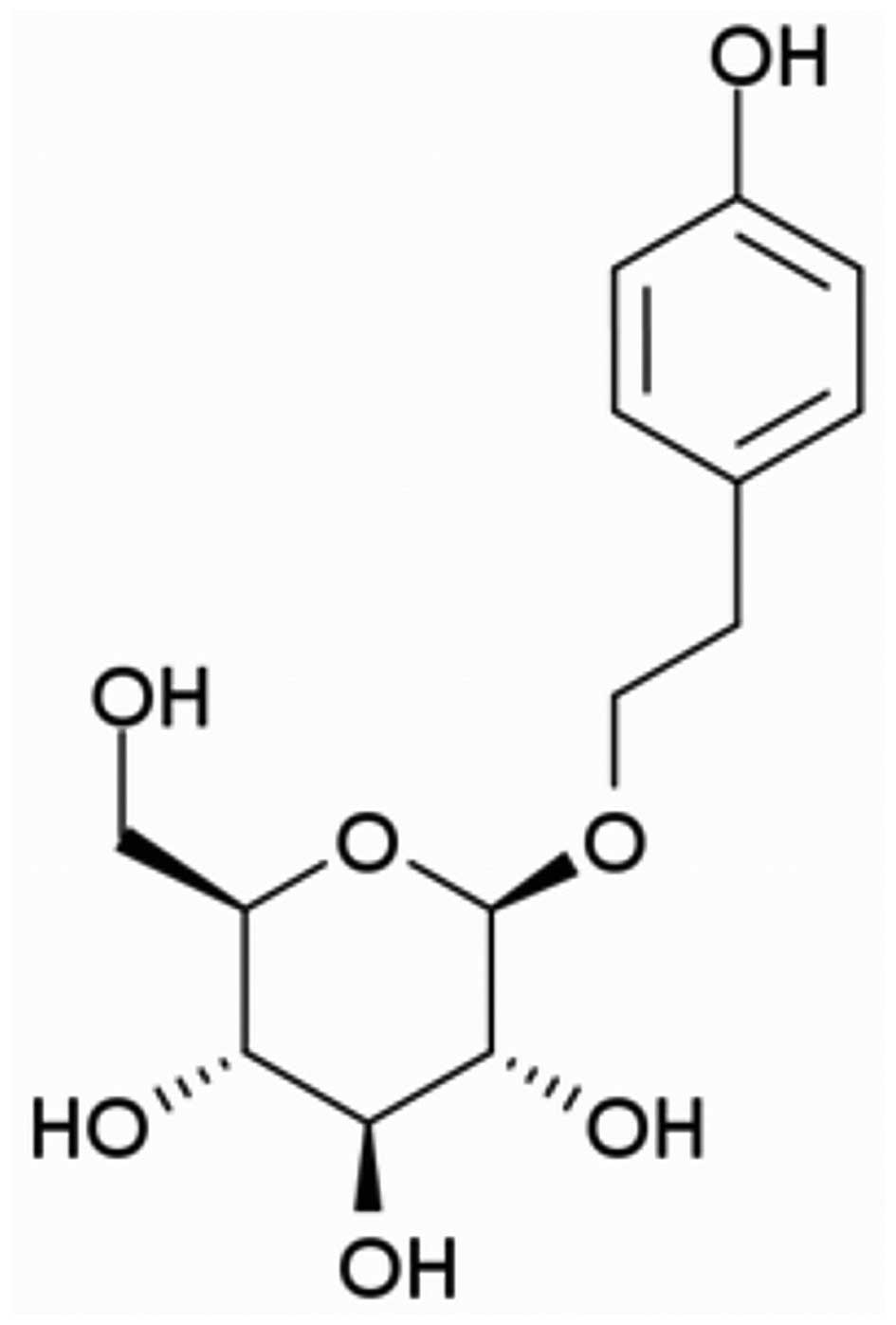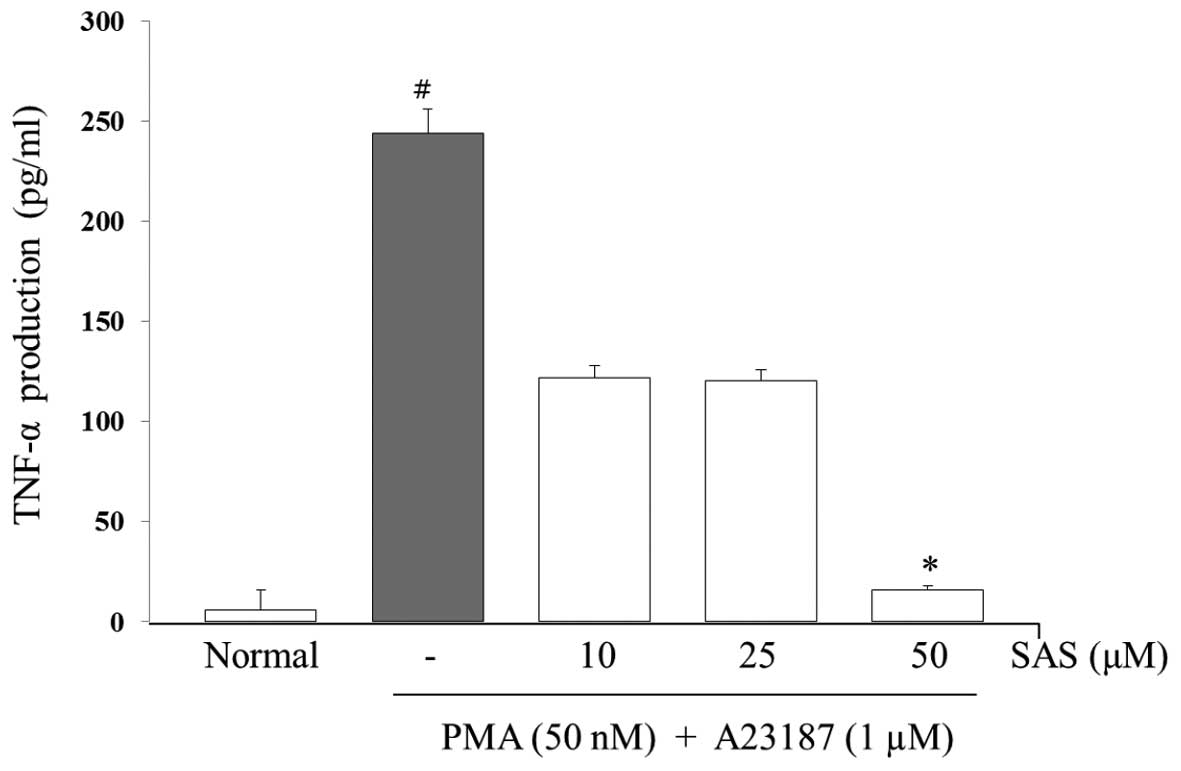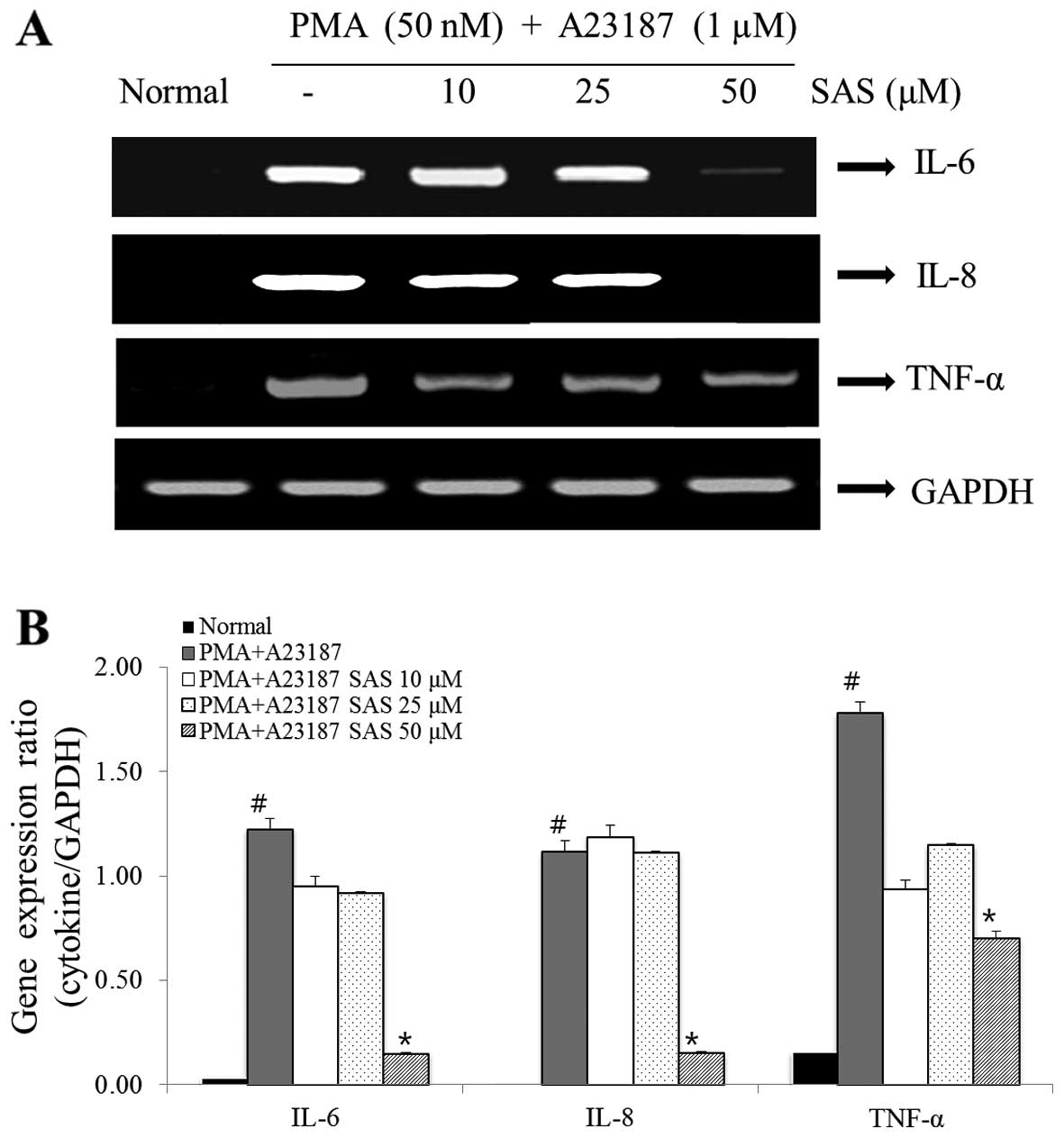|
1
|
Bischoff SC: Role of mast cells in
allergic and non-allergic immune responses: Comparison of human and
murine data. Nat Rev Immunol. 7:93–104. 2007. View Article : Google Scholar : PubMed/NCBI
|
|
2
|
Metz M and Maurer M: Mast cells–key
effector cells in immune responses. Trends Immunol. 28:234–241.
2007. View Article : Google Scholar : PubMed/NCBI
|
|
3
|
Butterfield JH, Weiler D, Dewald G and
Gleich GJ: Establishment of an immature mast cell line from a
patient with mast cell leukemia. Leuk Res. 12:345–355. 1988.
View Article : Google Scholar : PubMed/NCBI
|
|
4
|
Nilsson G, Blom T, Kusche-Gullberg M,
Kjellén L, Butterfield JH, Sundström C, Nilsson K and Hellman L:
Phenotypic characterization of the human mast-cell line HMC-1.
Scand J Immunol. 39:489–498. 1994. View Article : Google Scholar : PubMed/NCBI
|
|
5
|
Xia HZ, Kepley CL, Sakai K, Chelliah J,
Irani AM and Schwartz LB: Quantitation of tryptase, chymase,
FcεRIα, and FcεRIγ mRNAs in human mast cells and basophils by
competitive reverse transcription-polymerase chain reaction. J
Immunol. 154:5472–5480. 1995.PubMed/NCBI
|
|
6
|
Xia YC, Sun S, Kuek LE, Lopata AL, Hulett
MD and Mackay GA: Human mast cell line-1 (HMC-1) cells transfected
with FcεRIα are sensitive to IgE/antigen-mediated stimulation
demonstrating selectivity towards cytokine production. Int
Immunopharmacol. 11:1002–1011. 2011. View Article : Google Scholar : PubMed/NCBI
|
|
7
|
Grützkau A, Krüger-Krasagakes S, Kögel H,
Möller A, Lippert U and Henz BM: Detection of intracellular
interleukin-8 in human mast cells: Flow cytometry as a guide for
immunoelectron microscopy. J Histochem Cytochem. 45:935–945. 1997.
View Article : Google Scholar : PubMed/NCBI
|
|
8
|
Kang OH, Jang HJ, Chae HS, Oh YC, Choi JG,
Lee YS, Kim JH, Kim YC, Sohn DH and Park H: Anti-inflammatory
mechanisms of resveratrol in activated HMC-1 cells: Pivotal roles
of NF-kappaB and MAPK. Pharmacol Res. 59:330–337. 2009. View Article : Google Scholar : PubMed/NCBI
|
|
9
|
Zhu Z, Homer RJ, Wang Z, Chen Q, Geba GP,
Wang J, Zhang Y and Elias JA: Pulmonary expression of
interleukin-13 causes inflammation, mucus hypersecretion,
subepithelial fibrosis, physiologic abnormalities, and eotaxin
production. J Clin Invest. 103:779–788. 1999. View Article : Google Scholar : PubMed/NCBI
|
|
10
|
Kim HH, Bae Y and Kim SH: Galangin
attenuates mast cell-mediated allergic inflammation. Food Chem
Toxicol. 57:209–216. 2013. View Article : Google Scholar : PubMed/NCBI
|
|
11
|
Kumar A, Abbas W and Herbein G: TNF and
TNF receptor superfamily members in HIV infection: New cellular
targets for therapy? Mediators Inflamm. 2013:4843782013. View Article : Google Scholar
|
|
12
|
Rose-John S: IL-6 trans-signaling via the
soluble IL-6 receptor: importance for the pro-inflammatory
activities of IL-6. Int J Biol Sci. 8:1237–1247. 2012. View Article : Google Scholar : PubMed/NCBI
|
|
13
|
Zhang N, Xu Y, Zhang B, Zhang T, Yang H,
Zhang B, Feng Z and Zhong D: Analysis of interleukin-8 gene
variants reveals their relative importance as genetic
susceptibility factors for chronic periodontitis in the Han
population. PLoS One. 9:e1044362014. View Article : Google Scholar : PubMed/NCBI
|
|
14
|
Remick DG: Interleukin-8. Crit Care Med.
33(Suppl 12): S466–S467. 2005. View Article : Google Scholar : PubMed/NCBI
|
|
15
|
Kim EK and Choi EJ: Pathological roles of
MAPK signaling pathways in human diseases. Biochim Biophys Acta.
1802:396–405. 2010. View Article : Google Scholar : PubMed/NCBI
|
|
16
|
Xia Z, Dickens M, Raingeaud J, Davis RJ
and Greenberg ME: Opposing effects of ERK and JNK-p38 MAP kinases
on apoptosis. Science. 270:1326–1331. 1995. View Article : Google Scholar : PubMed/NCBI
|
|
17
|
Mao Y, Li Y and Yao N: Simultaneous
determination of salidroside and tyrosol in extracts of Rhodiola L.
by microwave assisted extraction and high-performance liquid
chromatography. J Pharm Biomed Anal. 45:510–515. 2007. View Article : Google Scholar : PubMed/NCBI
|
|
18
|
Zheng W and Wang SY: Antioxidant activity
and phenolic compounds in selected herbs. J Agric Food Chem.
49:5165–5170. 2001. View Article : Google Scholar : PubMed/NCBI
|
|
19
|
Peschel W, Prieto JM, Karkour C and
Williamson EM: Effect of provenance, plant part and processing on
extract profiles from cultivated European Rhodiola rosea L. for
medicinal use. Phytochemistry. 86:92–102. 2013. View Article : Google Scholar
|
|
20
|
Perfumi M and Mattioli L: Adaptogenic and
central nervous system effects of single doses of 3% rosavin and 1%
salidroside Rhodiola rosea L. extract in mice. Phytother Res.
21:37–43. 2007. View
Article : Google Scholar
|
|
21
|
Yousef GG, Grace MH, Cheng DM, Belolipov
IV, Raskin I and Lila MA: Comparative phytochemical
characterization of three Rhodiola species. Phytochemistry.
67:2380–2391. 2006. View Article : Google Scholar : PubMed/NCBI
|
|
22
|
Ming DS, Hillhouse BJ, Guns ES, Eberding
A, Xie S, Vimalanathan S and Towers GH: Bioactive compounds from
Rhodiola rosea (Crassulaceae). Phytother Res. 19:740–743. 2005.
View Article : Google Scholar : PubMed/NCBI
|
|
23
|
Richard P, Brown MD, Patricia L, Gerbarg
MD and Zakir Ramazanov DS: Rhodiola rosea: A phytomedicinal
overview. HerbalGram. 56:40–52. 2002.
|
|
24
|
Zhu Y, Shi YP, Wu D, Ji YJ, Wang X, Chen
HL, Wu SS, Huang DJ and Jiang W: Salidroside protects against
hydrogen peroxide-induced injury in cardiac H9c2 cells via PI3K-Akt
dependent pathway. DNA Cell Biol. 30:809–819. 2011. View Article : Google Scholar : PubMed/NCBI
|
|
25
|
Tan CB, Gao M, Xu WR, Yang XY, Zhu XM and
Du GH: Protective effects of salidroside on endothelial cell
apoptosis induced by cobalt chloride. Biol Pharm Bull.
32:1359–1363. 2009. View Article : Google Scholar : PubMed/NCBI
|
|
26
|
Chen X, Zhang Q, Cheng Q and Ding F:
Protective effect of salidroside against
H2O2-induced cell apoptosis in primary
culture of rat hippocampal neurons. Mol Cell Biochem. 332:85–93.
2009. View Article : Google Scholar : PubMed/NCBI
|
|
27
|
Wang J, Xiao L, Zhu L, Hu M, Wang Q and
Yan T: The effect of synthetic salidroside on cytokines and airway
inflammation of asthma induced by diisocyanate (TDI) in mice by
regulating GATA3/T-bet. Biochem Biophys Res Commun. 451:79–85.
2014.
|
|
28
|
Yan GH and Choi YH: Salidroside attenuates
allergic airway inflammation through negative regulation of nuclear
factor-kappa B and p38 mitogen-activated protein kinase. J
Pharmacol Sci. 126:126–135. 2014. View Article : Google Scholar : PubMed/NCBI
|
|
29
|
Bradding P and Holgate ST: Immunopathology
and human mast cell cytokines. Crit Rev Oncol Hematol. 31:119–133.
1999. View Article : Google Scholar : PubMed/NCBI
|
|
30
|
Hide I, Toriu N, Nuibe T, Inoue A, Hide M,
Yamamoto S and Nakata Y: Suppression of TNF-alpha secretion by
azelastine in a rat mast (RBL-2H3) cell line: Evidence for
differential regulation of TNF-alpha release, transcription, and
degranulation. J Immunol. 159:2932–2940. 1997.PubMed/NCBI
|
|
31
|
Vandenabeele P, Declercq W, Van Herreweghe
F and Vanden Berghe T: The role of the kinases RIP1 and RIP3 in
TNF-induced necrosis. Sci Signal. 3:re42010. View Article : Google Scholar : PubMed/NCBI
|
|
32
|
Walczak H: TNF and ubiquitin at the
crossroads of gene activation, cell death, inflammation, and
cancer. Immunol Rev. 244:9–28. 2011. View Article : Google Scholar : PubMed/NCBI
|
|
33
|
Mican JA, Arora N, Burd PR and Metcalfe
DD: Passive cutaneous anaphylaxis in mouse skin is associated with
local accumulation of interleukin-6 mRNA and immunoreactive
interleukin-6 protein. J Allergy Clin Immunol. 90:815–824. 1992.
View Article : Google Scholar : PubMed/NCBI
|
|
34
|
Lin TJ, Garduno R, Boudreau RT and
Issekutz AC: Pseudomonas aeruginosa activates human mast cells to
induce neutrophil transendothelial migration via mast cell-derived
IL-1 alpha and beta. J Immunol. 169:4522–4530. 2002. View Article : Google Scholar : PubMed/NCBI
|
|
35
|
Law M, Morales JL, Mottram LF, Iyer A,
Peterson BR and August A: Structural requirements for the
inhibition of calcium mobilization and mast cell activation by the
pyrazole derivative BTP2. Int J Biochem Cell Biol. 43:1228–1239.
2011. View Article : Google Scholar : PubMed/NCBI
|
|
36
|
Crossthwaite AJ, Hasan S and Williams RJ:
Hydrogen peroxide-mediated phosphorylation of ERK1/2, Akt/PKB and
JNK in cortical neurones: Dependence on Ca(2+) and PI3-kinase. J
Neurochem. 80:24–35. 2002. View Article : Google Scholar : PubMed/NCBI
|
|
37
|
Duan W and Wong WS: Targeting
mitogen-activated protein kinases for asthma. Curr Drug Targets.
7:691–698. 2006. View Article : Google Scholar : PubMed/NCBI
|
|
38
|
Mizuno T, Hisamoto N, Terada T, Kondo T,
Adachi M, Nishida E, Kim DH, Ausubel FM and Matsumoto K: The
Caenorhabditis elegans MAPK phosphatase VHP-1 mediates a novel
JNK-like signaling pathway in stress response. EMBO J.
23:2226–2234. 2004. View Article : Google Scholar : PubMed/NCBI
|
|
39
|
Cargnello M and Roux PP: Activation and
function of the MAPKs and their substrates, the MAPK-activated
protein kinases. Microbiol Mol Biol Rev. 75:50–83. 2011. View Article : Google Scholar : PubMed/NCBI
|
|
40
|
Roux PP and Blenis J: ERK and p38
MAPK-activated protein kinases: A family of protein kinases with
diverse biological functions. Microbiol Mol Biol Rev. 68:320–344.
2004. View Article : Google Scholar : PubMed/NCBI
|
|
41
|
DiDonato JA, Mercurio F and Karin M: NF-κB
and the link between inflammation and cancer. Immunol Rev.
246:379–400. 2012. View Article : Google Scholar : PubMed/NCBI
|
|
42
|
Pasparakis M: Role of NF-κB in epithelial
biology. Immunol Rev. 246:346–358. 2012. View Article : Google Scholar : PubMed/NCBI
|


















